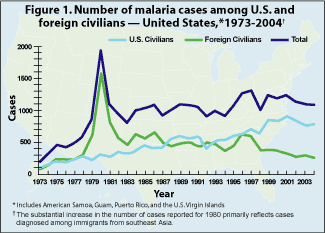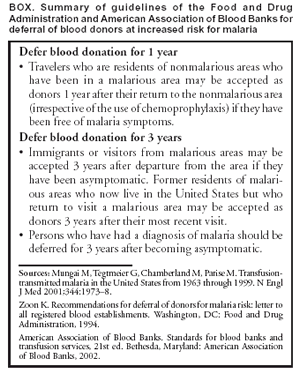|
|
|||||
|
|
Malaria has been eradicated in certain areas where it was previously endemic. Despite the interruption of transmission, these areas are often at risk for the reintroduction of the parasite. This risk is unlikely to abate given migration and travel patterns as well as the ongoing presence of competent mosquito vectors. Most malaria cases that do occur in malaria-free areas are credited to persons returning to the country from visiting or moving from endemic areas ("imported" malaria). However other mechanisms for cases to occur include "airport" malaria, locally transmitted mosquito borne cases, congenital malaria, and through blood transfusions and organ transplants.
Imported MalariaIn the United States, about 1,200 malaria cases are reported annually which are mostly attributed to imported malaria. These cases describe travelers or immigrants coming from malaria endemic areas, where they were infected, and developing signs of malaria after arriving in the United States. Imported malaria cases will continue to be a problem for the foreseeable future, as the mobility of tourists and migrants is increasing. Prompt reporting of patients with malaria to public health authorities and adequate assessment of risk factors for malaria in all cases allows initiation of an appropriate public health response to prevent reestablishment of malaria transmission. Therefore, continued domestic surveillance and prompt diagnosis and treatment are crucial to prevent the reintroduction of malaria into areas that are currently malaria-free. Malaria
Surveillance United States 2004
Locally Transmitted Mosquito-Borne MalariaOutbreaks of locally transmitted cases of malaria in the United States have been small and relatively isolated, but the potential risk for the disease to re-emerge is present due to the abundance of competent vectors, especially in the southern states. At the request of the states, CDC assists in these investigations of locally transmitted mosquito borne malaria. The most recent collaborative investigation identified an outbreak of malaria in Palm Beach County, Florida. "Airport" Malaria"'Airport" malaria refers to malaria caused by infected mosquitoes that are transported rapidly by aircraft from a malaria-endemic country to a non-endemic country. If the local conditions allow their survival, they can bite local residents who can thus acquire malaria without having traveled abroad Congenital MalariaIn congenital malaria, infected mothers transmit parasites to their child during pregnancy before or during delivery. Therefore, though congenital transmission is rare, health-care providers should be alert to the diagnosis of malaria in ill neonates and young infants, particularly those with fever. During evaluation, health-care providers should obtain a complete and accurate travel and residency history on the patient and close relatives. Patients should be asked about transfusion of blood products. The absence of recent foreign travel or a long interval between immigration of the mother and the birth of the infant being examined should not discourage clinicians from obtaining blood films on the patient to rule out a potentially life-threatening but treatable infection. See Congenital Malaria as a Result of Plasmodium malariae - North Carolina, 2000 Infected Blood ProductsTransfusion-transmitted malaria (TTM) is rare in the United States, but it is a potential severe complication in blood recipients. Only about one case of malaria occurs for every 4 million units of blood collected. Because no approved tests are available in the United States to screen donated blood for malaria, prevention of transfusion-transmitted malaria requires careful questioning of prospective donors. See Transfusion-Transmitted Malaria - Missouri and Pennsylvania, 1996-1998.
Page last modified : May 4, 2004 Content source: Division of Parasitic Diseases National Center for Zoonotic, Vector-Borne, and Enteric Diseases (ZVED)
|
|
|||||||||||||||||||||||
| Home | Policies and Regulations | Disclaimer | e-Government | FOIA | Contact Us | ||||||
|





